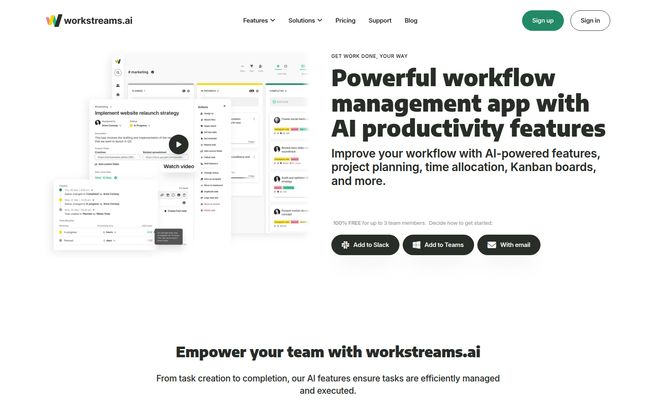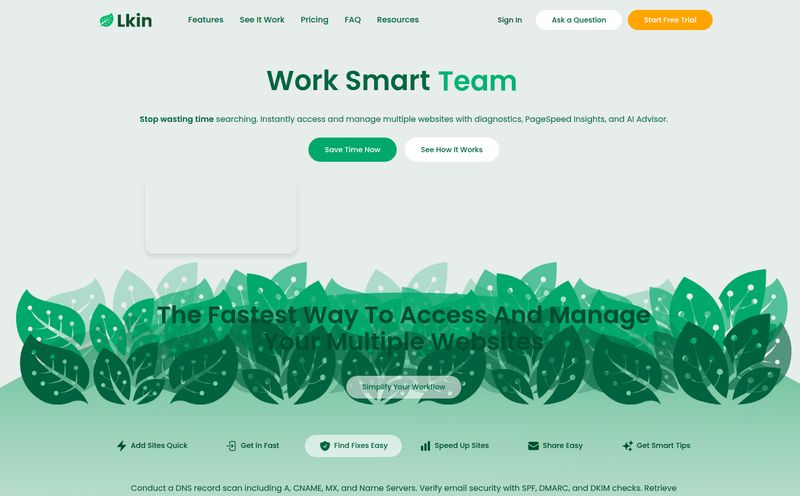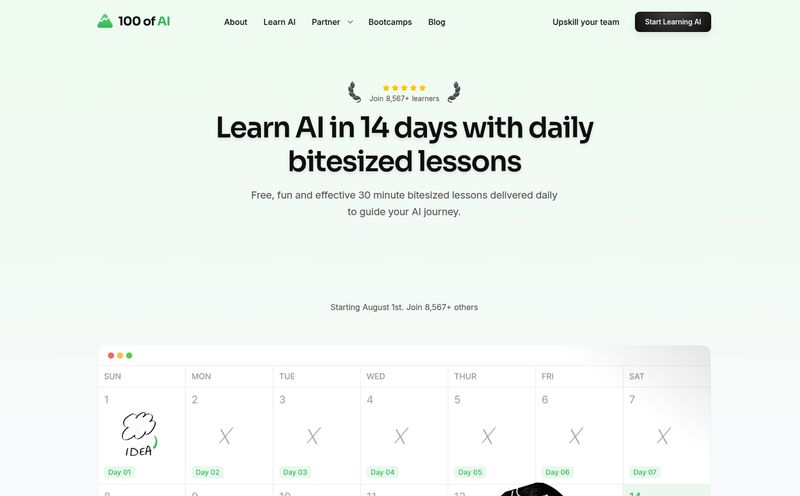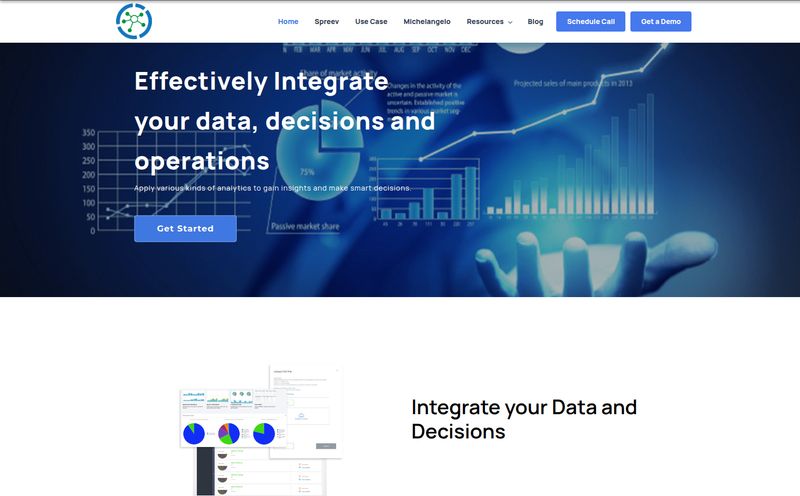How many of your brilliant, world-changing ideas have died a quiet death in a forgotten Slack channel? You know the ones. Someone types, “Hey, we should totally do X!” and everyone chimes in with a fire emoji, and then… crickets. The idea gets buried under a mountain of Gifs and weekend plans. It’s the black hole of modern productivity.
I’ve been in the SEO and traffic game for years, and I’ve seen this happen on every team I’ve worked with. We've tried them all: Trello, Asana, Monday, even the dreaded Jira. And the biggest hurdle, every single time, is getting the team to break their habits and actually use the darn thing. The friction of switching from your chat app to your project management tool is a real productivity killer.
So when I stumbled upon workstreams.ai, my curiosity was definitely piqued. Their whole pitch isn’t about having a million more features than the next guy. It’s about putting those features right where you’re already working. Can a tool really tame the chaos of our chat-first work lives? I decided to find out.
So, What Exactly is workstreams.ai?
At its core, workstreams.ai is a visual project management platform. You get your Kanban boards, your task cards, and your workflows—all the stuff you'd expect. But here's the kicker: it’s designed from the ground up to live inside Slack and Microsoft Teams.
Think of it this way. Most project management tools are like a separate office building you have to commute to. You leave your main communication hub (Slack), travel over to this other app, do your work, and then travel back. workstreams.ai is more like a smart, interactive whiteboard that’s been installed directly in your virtual breakroom. The work happens where the conversation happens. It’s a subtle shift, but a powerful one. You can turn any message into a task with a click, assign it, and track it without ever leaving your chat window. Now that's interesting.

Visit workstreams.ai
The Features That Actually Matter
A feature list is just a list. What matters is how those features solve real problems. After playing around with it, a few things really stood out to me as being more than just marketing fluff.
The Slack and Teams Integration is the Real MVP
I can’t overstate this. This is the whole show. The ability to create a task directly from a chat message is a genuine game-changer. That frantic moment when a client gives feedback in a random channel, and you're scrambling to copy-paste it into your to-do list before it gets lost? Gone. Just use the message action, and boom—it's a task on your board, complete with the original context.
This single feature demolishes the biggest barrier to adoption for any PM tool: user friction. There’s no more, “I’ll add that to the board later” and then promptly forgetting. It’s immediate and it's intuitive.
Taming the Chaos with Smart Workflows
Okay, so lots of tools have automation. But workstreams.ai focuses on standardizing your actual processes. If you’re a marketing manager, for example, you can build a workflow for your content pipeline. An article idea can start in the 'Ideas' column, then move to 'Writing,' 'Review,' and 'Published,' with specific people automatically notified at each stage. It takes the guesswork and the constant “Hey, is this ready for me to look at?” pings out of the equation. It's about creating predictable patterns for recurring work, which, as any agency veteran will tell you, is the holy grail.
More Than Just To-Do Lists
I was also pleasantly surprised by some of the deeper features. You can set time allocations for tasks, which is great for sprint planning and for getting a realistic sense of your team's bandwidth. It also has built-in performance tracking, so you can see bottlenecks and celebrate wins without having to pull a dozen different reports. They even have a neat little feature for “Frozen Tasks”—a designated place for those good ideas that you just can’t get to right now. It's so much better than a 'Backlog' column that becomes a graveyard of forgotten dreams.
Let's Talk Money: The workstreams.ai Pricing Breakdown
Alright, the all-important question. How much is this going to cost me? The pricing structure is refreshingly straightforward, which I always appreciate. No hidden fees or confusing credit systems.
Here’s a quick look at the plans:
| Plan | Price | Who It's For |
|---|---|---|
| Free | $0 (Forever) | Small teams of 3 members or less, or for trying it out. |
| Pro | $7.99 /user/month (billed annually) | The sweet spot for most modern teams who need the full feature set. |
| Enterprise | Custom | Large organizations needing tailored solutions, security, and support. |
My take? The Free plan is genuinely useful. For a small startup, a personal project, or a tiny team within a larger company, getting this level of functionality for free is a fantastic deal. The 3-member cap is the main limitation, but it’s a fair one.
The Pro plan is where the magic happens. At about eight bucks a user, it's competitively priced against the likes of Trello or Asana's paid tiers. But what you're buying here isn't just another Kanban board—you're buying integration. You're buying back the time your team wastes switching between apps. In my opinion, if your team is heavy on Slack or Teams, that price is a no-brainer.
The Good, The Bad, and The… Slightly Annoying
No tool is perfect, right? Here’s my brutally honest breakdown.
The Good Stuff
I've gotta say, the deep integration is the star. It really does feel like it was built by people who have felt the pain of fragmented work. The workflow automation is powerful without being overly complex, and the ability to customize boards for different projects—from a content calendar to a bug tracker—is incredibly useful. It's flexible.
The Not-So-Good Stuff
That 3-user limit on the free plan is a hard gate. If you're a team of four, you're out of luck and have to jump straight to paid. Also, there can be a bit of a learning curve. It's not as instantly simple as a blank Trello board, but thats because it has more moving parts. You have to invest a little time in setting up your workflows to get the most out of it. And, of course, some of the best features, like advanced reporting and unlimited workflows, are locked behind that Pro plan paywall.
Who is This Tool REALLY For?
So, who should drop what they're doing and try this?
- Teams that LIVE in Slack or Microsoft Teams. If your company culture revolves around chat, this tool will feel like an extension of your existing brain.
- Managers who need clarity. If you want to see who's working on what and how long it's taking, without having to constantly ask for updates, the time allocation and tracking features are gold.
- Agile-ish teams. I say 'agile-ish' because it's flexible enough for true scrum teams but also simple enough for teams that just want to organize their work into sprints and track progress visually.
Who might want to pass? Probably solo freelancers who don't need heavy collaboration features, or huge companies that are already deeply, unchangeably committed to a behemoth like Jira. For everyone else in between, it's definitely worth a look.
Frequently Asked Questions about workstreams.ai
Can I use workstreams.ai without Slack or Microsoft Teams?
While you can access the web app directly, the real power and intended experience come from the integration. Using it without Slack or Teams would be like buying a sports car and only driving it in school zones—you're missing the whole point.
How does workstreams.ai compare to Trello or Asana?
Trello is simpler and perhaps faster for basic to-do lists. Asana is a bit more powerful for complex project planning with dependencies and timelines. workstreams.ai's unique advantage is its native, deep integration into chat. It prioritizes reducing context-switching over having the longest feature list.
Is the Pro plan worth it for a small team of, say, 5 people?
In my opinion, yes. If those 5 people are constantly collaborating in chat, the monthly cost (around $40) is easily justified by the time you'll save and the ideas you'll stop losing. Calculate how much one forgotten task or one missed deadline costs you—it probably pays for itself quickly.
What's the learning curve like for my team?
It’s moderate. The basics of creating tasks are super simple, especially from within Slack. Setting up your first custom workflow might take an hour or so of focused effort. It’s more involved than Trello but far less intimidating than something like Jira.
Is my data secure with workstreams.ai?
According to their site, they take security seriously. They mention being GDPR compliant and using secure data encryption. As with any cloud tool, you should review their specific security policies, but they appear to follow industry standards.
My Final Verdict
In a very, very crowded market of project management tools, workstreams.ai has managed to find a genuinely unique and valuable position. It's not trying to out-feature everyone else. Instead, it’s solving the most fundamental problem of all: getting your team to actually use the tool you're paying for.
By meeting you where you already work, it transforms project management from a chore into a natural part of the conversation. If your Slack or Teams channels feel more like a chaotic suggestion box than a productivity hub, I'd strongly suggest giving the workstreams.ai free plan a spin. You might be surprised at the order you can find in the chaos.



